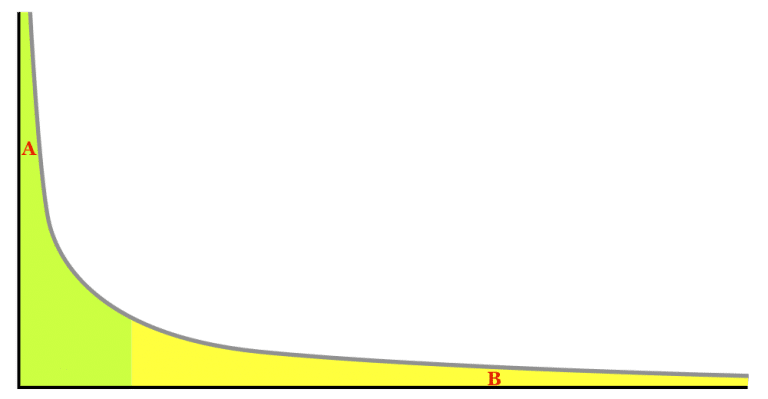I was meeting with a client and our marketing director (Mike) the other day discussing trends in search engine optimization, and all of a sudden, out of Mike’s mouth popped the phrase “long tail keywords”. Mike kept plowing ahead, but I could see that telltale glaze start to form over the client’s eyes as he was searching for someway to make meaning out of what Mike was talking about and a weird term like “long tail”. It made me realize that we were, yet again, spouting some jargon that we intuitively understand, but that required a layman’s translation. The good news is, that although it might sound as if it should be in a discussion of pet anatomy, the term “long tail” as is relates to search engine optimization really does make sense, and using it as a strategy for generating traffic is a sound one.
So, where does the term “long tail” come from?
Above is a small diagram of a “power law” graph which graphically displays a functional relationship between two quantities, where one quantity varies as a power of another. The section of the graph in yellow is the “long tail”, the section in green is the “short tail”. In the case of search engine optimization the vertical axis represents the number of search results and the horizontal axis represents the decreasing popularity of the keyword being searched. For instance, if you did a search on Google for “website marketing” you’ll get many, many pages of search results (point “A” on the graph – a very popular, high cost search phrase). A search for “ecommerce website marketing firm in colorado springs”, you’ll see way less search results (point “B” in the graph – a less popular, less costly phrase). Because in many cases, the cost of search engine optimization is directly related to how popular the keywords being searched are, “long tail” keywords are less costly to optimize for than short tail keywords. So, a very valid strategy is to optimize a website for long tail keywords because in aggregate, they can generate as much traffic as popular keywords, but at a much lower overall cost.
This point can also be illustrated by comparing the costs per click of various keywords. For example, the cost per click to Google for “real estate” might be $10 per click – a very high cost for a short tail phrase. Because the phrase is so general, so popular, and so powerful it’s expensive to get it to show up on page 1 of the search results pages. On the other hand, the cost per click for “colorado springs real estate” might be only $2.00 per click because it’s not nearly as popular a search phrase as just “real estate”. In this example, “colorado springs real estate” would be a “long tail” keyword and the cost for that keyword is significantly less than its short tailed counterpart. By finding lots of long tail keywords and phrases, we can compete for traffic against the high cost short tail keywords and phrases.
So – despite the long winded explanation, I think you can see that having a long tail strategy is a good thing. Our marketing professionals are experts at helping maximize your online marketing budget by using strategic concepts like long tail keywords to help drive more traffic and customers to your website.

Allan Todd is CEO of Pagecafe Digital Marketing. In 2022, Allan teamed up with Infront Webworks to provide digital marketing, website design, content marketing, SEO and strategy and solutions to local businesses. Allan lives in Colorado Springs.


